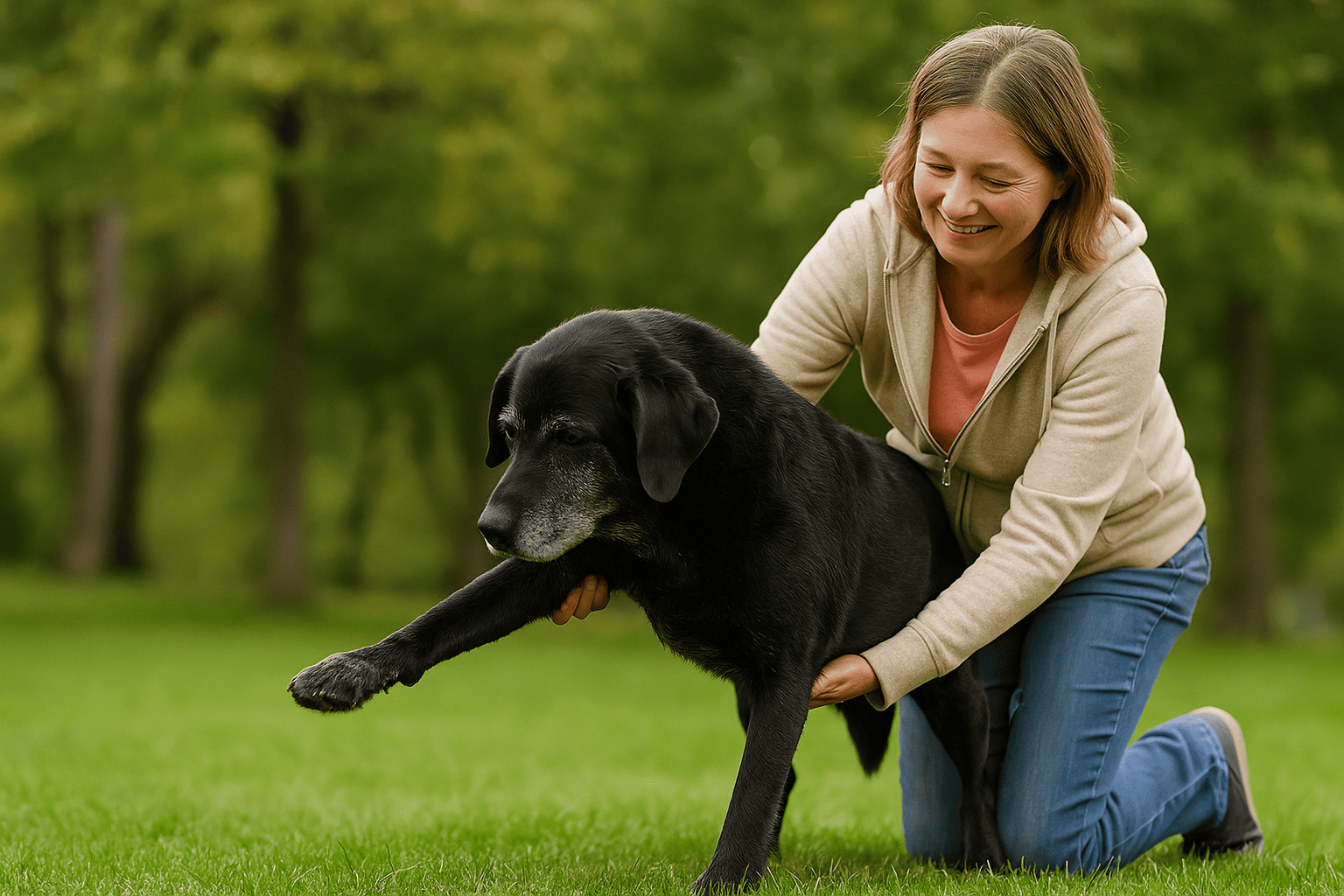Introduction
Arthritis is a common challenge for senior dogs, causing joint pain, stiffness, and reduced mobility. As dogs age, their joints naturally wear down, making everyday activities like walking or climbing stairs difficult. However, keeping senior dogs with arthritis active is vital for their physical and mental well-being. Gentle, adapted exercises can strengthen muscles, improve circulation, and reduce joint discomfort, helping your dog live a happier, healthier life. In this article, we’ll share five practical tips to safely adapt daily exercises for senior dogs with arthritis, ensuring they stay active without pain or injury.
Understanding Canine Arthritis
What Is Arthritis in Dogs?
Arthritis in dogs is a chronic condition where joint inflammation leads to pain and limited movement. The cartilage cushioning the bones wears down, causing bone-on-bone friction. This results in swelling, discomfort, and reduced mobility, especially in senior dogs. Osteoarthritis, also called degenerative joint disease, is the most common form affecting aging pets.
Signs of Arthritis in Senior Dogs
Recognizing arthritis early helps you adapt your dog’s routine effectively. Look for these symptoms:
- Difficulty standing up after resting
- Hesitation to climb stairs or jump into cars
- Limping or favoring one leg after activity
- Increased time spent lying down
- Irritability or lethargy due to pain
- Visible joint swelling or stiffness
These signs often worsen over time, so monitor your dog closely and consult a vet if you notice changes.
How Arthritis Impacts Mobility
Arthritis makes movement painful for senior dogs, as inflamed joints hurt with every step. This discomfort leads to less activity, causing muscle loss and weaker joints. Weak muscles provide less joint support, creating a cycle of reduced mobility and increased pain. Adapting exercises for senior dogs with arthritis breaks this cycle by promoting safe movement, preserving muscle strength, and improving joint function.
Benefits of Adapted Exercises
Gentle exercises tailored for senior dogs with arthritis offer significant physical and mental benefits. Here’s why they matter:
- Improved Circulation: Light activity boosts blood flow, delivering nutrients to joints and reducing inflammation.
- Stronger Muscles: Regular movement maintains muscle tone, supporting joints and reducing strain.
- Reduced Stiffness: Gentle exercises loosen joints, easing discomfort caused by inactivity.
- Better Mental Health: Exercise releases endorphins, improving mood and reducing stress or depression from chronic pain.
These benefits enhance your dog’s quality of life, keeping them active and happy.
Safe Exercises for Senior Dogs with Arthritis
Short, Frequent Walks
Walking is excellent for senior dogs with arthritis when adjusted properly. Opt for short walks (5-10 minutes) multiple times daily at a slow pace. Choose soft surfaces like grass or rubber mats to minimize joint impact. Avoid hard concrete or slippery tiles to prevent falls and strain.
Swimming and Hydrotherapy
Swimming is a top low-impact exercise for senior dogs with arthritis. It allows full-body movement without stressing joints, improving mobility and reducing pain. Use warm water and supervise your dog closely. Hydrotherapy sessions at a vet clinic can also be highly effective.
Gentle Stretching
Simple stretches improve flexibility and relieve muscle tightness. Gently extend your dog’s legs or guide their spine through light stretches, moving slowly and stopping if they show discomfort. Consult your vet for safe stretching techniques tailored to your dog’s condition.
Low-Impact Play
Playtime can still be fun for arthritic dogs with the right activities. Try low-impact games like hide-and-seek with treats or slow-paced interactive toys. Avoid high-energy games like fetch, which involve jumping or running and may worsen joint pain.
Tips to Prevent Injuries
To keep exercises safe for senior dogs with arthritis, follow these precautions:
- Monitor for Pain: Watch for limping, whining, or reluctance to move. Stop immediately if your dog seems uncomfortable.
- Use Support Equipment: Harnesses distribute weight evenly during walks, and ramps help with furniture or car access, reducing joint strain.
- Incorporate Rest Breaks: Arthritic dogs tire quickly, so include frequent breaks during activities to prevent overexertion.
- Avoid Risky Surfaces: Stick to non-slip surfaces like grass and avoid stairs, which can stress joints.
Veterinary Support and Physical Therapy
Consult Your Veterinarian
Before starting any exercise plan, consult a vet to assess your dog’s joint health and mobility. They’ll recommend safe activities tailored to your dog’s needs, preventing injuries or overexertion. Veterinary guidance is critical for senior dogs with arthritis.
Benefits of Canine Physical Therapy
Physical therapy, including massages, passive stretches, and hydrotherapy, relieves pain and improves flexibility. Professional therapists use techniques like laser therapy or heat therapy to reduce inflammation and support recovery, complementing daily exercises.
Conclusion
Adapting exercises for senior dogs with arthritis is a powerful way to support their health and happiness. With low-impact activities like swimming, short walks, and gentle stretches, plus veterinary guidance, your dog can stay active and pain-free. Start implementing these tips today to improve your dog’s quality of life, and share your experiences in the comments below!

